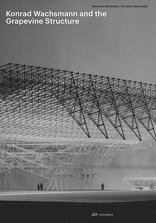Publikation
Konrad Wachsmann and the Grapevine Structure
ISBN: 978-3-03860-110-4
Beiträge von: Fabio Gramazio, Matthias Kohler, and Hannes Mayer; Andreas Burkhalter; and a conversation with Hermann Czech and Friedrich Kurrent by Mario Pogacnik
Sprache: English
Publikationsdatum: 2018
Umfang: 152 pages, 91 color, 50 duotone, and 40 b/w illustrations
Format: Flexocover, 23 x 32 cm
German modernist architect Konrad Wachsmann (1901–80) had a career-spanning interest in construction processes—in particular the prefabrication of building components and their assembly within modular systems. In this respect, Wachsmann was a pioneer whose ideas and work paved the way for today’s industrialized construction.
Marianne Burkhalter and Christian Sumi synthesize years of careful research into a compelling look at this highly creative architect. At the core of the book is Wachsmann’s dynamic Grapevine Structure, a universal construction element developed with students during his tenure at the Chicago Institute of Design—part of what is today the Illinois Institute of Technology. The book also investigates Wachsmann’s Packaged House System, his relocatable hangars for the US Air Force, and, in particular, the Local Orientation Manipulator (LOM), developed with John Bollinger and Xavier Mendoza at the University of California, Los Angeles. Fabio Gramazio, Matthias Kohler, and Hannes Mayer (Gramazio Kohler Research, ETH Zurich) revisit the LOM from a contemporary perspective where robotic fabrication processes have become increasingly common. The book also features an essay by Andreas Burkhalter on Wachsmann’s legendary knotted joints in the context of possible similar structures in the human brain, and a conversation by Marko Pogacnik with architects Hermann Czech and Friedrich Kurrent on Wachsmann’s lectures at the Salzburg Summer Academy.
Published to coincide with an exhibition on Konrad Wachsmann at the 2018 International Architecture Exhibition of the Venice Biennale, the book features rich illustrative material.
Marianne Burkhalter and Christian Sumi synthesize years of careful research into a compelling look at this highly creative architect. At the core of the book is Wachsmann’s dynamic Grapevine Structure, a universal construction element developed with students during his tenure at the Chicago Institute of Design—part of what is today the Illinois Institute of Technology. The book also investigates Wachsmann’s Packaged House System, his relocatable hangars for the US Air Force, and, in particular, the Local Orientation Manipulator (LOM), developed with John Bollinger and Xavier Mendoza at the University of California, Los Angeles. Fabio Gramazio, Matthias Kohler, and Hannes Mayer (Gramazio Kohler Research, ETH Zurich) revisit the LOM from a contemporary perspective where robotic fabrication processes have become increasingly common. The book also features an essay by Andreas Burkhalter on Wachsmann’s legendary knotted joints in the context of possible similar structures in the human brain, and a conversation by Marko Pogacnik with architects Hermann Czech and Friedrich Kurrent on Wachsmann’s lectures at the Salzburg Summer Academy.
Published to coincide with an exhibition on Konrad Wachsmann at the 2018 International Architecture Exhibition of the Venice Biennale, the book features rich illustrative material.
Weiterführende Links:
Park Books






